*Did you know that pickled vegetables have been a popular culinary tradition for centuries? With their tangy and flavorful profile, pickles add a delightful crunch to sandwiches, salads, and relish trays. But did you also know that achieving that perfect crunch in homemade pickles can be a bit challenging?*
From pickling recipes to the pickling process itself, there are several factors to consider if you want your pickled vegetables to have that satisfying bite. In this comprehensive guide, I’ll share essential tips and techniques to help you create crunchy and delicious pickles right in your own kitchen. Let’s dive in!
Key Takeaways:
- Using fresh vegetables is key to achieving crispy pickled vegetables.
- Choose the right vegetables with natural crispness, like cucumbers intended for pickling.
- Follow research-based pickling recipes for safe and flavorful results.
- Consider low-temperature pasteurization or refrigerator pickling methods.
- Experiment with firming agents and other techniques to enhance pickle firmness.
Importance of Fresh Vegetables in Pickling
The crispness of pickled vegetables is directly influenced by the freshness of the vegetables used. As vegetables age, their pectin structure changes, causing them to become softer. This change can result from microbial activity, excess heat, or improper handling. To ensure the desired pickling crispness, it is important to start with just-picked vegetables that have not undergone this pectin degradation process. Fresh vegetables also tend to have better texture and flavor, leading to more satisfying pickles.
When vegetables are harvested, they possess a natural crispness and firmness due to the intact pectin structure. Pectin is a complex carbohydrate found in the cell walls of plants, and it contributes to the texture and firmness of fruits and vegetables. However, as vegetables age and are exposed to environmental factors, the pectin structure undergoes changes, resulting in softening.
Using fresh vegetables in pickling helps maintain the original pectin structure and crispness. Freshly harvested vegetables contain higher levels of pectin, which contributes to the desired crunchiness in pickles. The freshness also ensures that the vegetables haven’t undergone any microbial breakdown or heat-induced softening, which can compromise the pickling process.
Additionally, fresh vegetables tend to have better overall quality, including taste, color, and aroma. Their vibrant colors, robust flavors, and natural sweetness can enhance the overall sensory experience of pickled vegetables. By starting with high-quality, fresh vegetables, you can create pickles that not only have a satisfying crunch but also deliver exceptional taste and visual appeal.
Preserving the Freshness
Preserving the freshness of vegetables is crucial for achieving pickling crispness. Here are a few tips to ensure you’re working with the freshest vegetables:
- Harvest vegetables at their peak: Pick vegetables when they are fully mature, but before they become overripe or start showing signs of spoilage. This ensures that you capture them at their freshest and most flavorful stage.
- Grow your own or source locally: Consider growing your own vegetables or purchasing them from local farmers’ markets. Locally grown vegetables have shorter transportation times, reducing the risk of prolonged storage and deterioration.
- Proper storage: Store vegetables in a cool, dark place, such as a refrigerator or a root cellar. This helps slow down the natural aging process and preserves their crispness for a longer period.
- Minimal processing: Minimize the time between harvesting and pickling to preserve the vegetables’ crunchiness. Avoid subjecting them to excessive heat or rough handling, which can accelerate softening and pectin breakdown.
Choosing fresh vegetables is the first step towards pickling success. The quality and crunchiness of your pickles depend on the freshness of the vegetables you use. Don’t compromise on quality—opt for just-picked, top-notch vegetables, and enjoy the satisfying crunch of your homemade pickles.
| Benefits of Fresh Vegetables in Pickling | Fresher Taste | Better Texture | Higher Pectin Content |
|---|---|---|---|
| Usage of fresh vegetables contributes to the overall taste profile of pickles, resulting in a more vibrant and flavorful finished product. | Fresh vegetables provide a satisfying crunch and mouthfeel, enhancing the textural experience of pickled vegetables. | Just-picked vegetables retain higher levels of natural pectin, ensuring the desired crispness in pickles. |
Choosing the Right Vegetables for Pickling
When it comes to pickling, not all vegetables are created equal in terms of achieving that desired crunch. To ensure the perfect cucumber pickles and other crunchy delights, it’s crucial to choose the right vegetable varieties and follow proper preparation techniques.
Choosing the Perfect Cucumbers
For cucumber pickles, selecting the right type of cucumber is essential. Look for cucumbers specifically intended for pickling, ideally those that are no more than 2 inches in diameter. These smaller cucumbers have a higher natural crispness, making them perfect for achieving that satisfying crunch.
When preparing cucumbers for pickling, there’s an important step to remember: removing the blossom end. The blossom end harbors microbes that can lead to softening during the pickling process. By removing this end, you can ensure that your cucumbers remain crisp and delicious throughout the pickling journey.
Exploring Other Crispy Vegetable Varieties
While cucumbers are a classic choice for pickling, don’t limit yourself to just one vegetable. There are numerous crisp raw vegetable varieties that can yield tasty and crunchy pickled treats. Consider experimenting with options like carrots, green beans, cauliflower florets, or even bell peppers. These vegetables have a natural crispness that can add delightful texture to your pickled creations.
Vegetable Varieties for Crunchy Pickles
| Vegetable | Natural Crispness |
|---|---|
| Cucumbers | High |
| Carrots | Moderate |
| Green Beans | High |
| Cauliflower Florets | High |
| Bell Peppers | Moderate |
By selecting the right vegetable varieties and paying attention to proper preparation techniques, you can elevate your pickling game and enjoy a variety of crunchy pickled vegetables.
Using Safe and Research-Based Pickling Recipes
When it comes to pickling, safety should always be a top priority. Using research-based recipes is essential to ensure both the quality and safety of your pickles. By following trusted sources such as the USDA Complete Guide to Canning, the National Center for Home Food Preservation Website, or the Utah State University Extension Web site, you can rely on expert guidance to maintain the proper acidity levels in your pickling recipes.
Research-based recipes provide you with the knowledge and expertise necessary to create pickles that are not only delicious but also safe to consume. These recipes emphasize the importance of maintaining the proper acidity level, which is crucial for inhibiting the growth of harmful bacteria and ensuring long-term preservation.
By using these trusted recipes, you can confidently create pickles with the proper acidity level, resulting in safe and enjoyable pickling experiences. Whether you’re a seasoned pickler or just starting out, research-based recipes offer valuable insights and techniques that can elevate your pickling game.
Choose Trusted Sources for your Pickling Recipes
When searching for pickling recipes, it’s important to choose trusted sources that prioritize safety and quality. The USDA Complete Guide to Canning is a comprehensive resource that covers the entire canning process, including pickling. It provides detailed instructions, safety guidelines, and tested recipes to ensure optimal results.
Using research-based recipes is the key to safe and successful pickling. The USDA Complete Guide to Canning is a trusted resource that offers a wealth of information on pickling, including proper acidity levels and processing methods.
The National Center for Home Food Preservation Website is another reliable source that offers research-based recipes and guidelines for safe pickling. Their recipes have been tested and approved by experts, providing you with the confidence you need to create pickles that are both safe and delicious.
When it comes to pickling, it’s crucial to use recipes from trusted sources. The National Center for Home Food Preservation Website is a valuable resource that offers tested pickling recipes and safety guidelines to ensure the quality and safety of your pickles.
Additonally, the Utah State University Extension Web site provides a variety of research-based resources for home food preservation, including pickling. Their recipes and guidelines are backed by scientific research and expertise, offering you reliable information and techniques for safe pickling.
Safe Pickling = Proper Acidity Level
The proper acidity level is a critical factor in safe pickling. Acidity plays a vital role in preventing the growth of bacteria and preserving the integrity of your pickles. Research-based recipes focus on maintaining the ideal acidity level to ensure the safety and shelf life of your pickled products.
By using recipes from trusted sources, you can be confident that the acidity levels recommended have been thoroughly tested and proven to provide safe and high-quality pickles. These recipes take into account factors such as the type of vegetable being pickled and the processing method used, ensuring that the acidity level is appropriate for each specific recipe.
Using safe and research-based pickling recipes not only guarantees the proper acidity level but also allows you to explore a wide range of flavors and variations. With these recipes, you can venture into the world of pickling with confidence, knowing that your pickles will be both safe and delicious.
| Benefits of Using Research-Based Pickling Recipes | Why Trustworthy Sources Matter |
|---|---|
|
|
| Trusted Sources for Pickling Recipes | |
|
|
Low-Temperature Pasteurization for Pickling
When it comes to pickling, maintaining both safety and crunchiness is of utmost importance. One effective method to achieve this balance is low-temperature pasteurization.
During low-temperature pasteurization, cucumber pickles are processed at a temperature range of 180-185°F for a duration of 30 minutes. It’s crucial to carefully monitor the water temperature throughout the process to prevent pectin breakdown, which can lead to soft pickles.
By keeping the temperature below 185°F, you can ensure that your pickles maintain the desired crispness that makes them so enjoyable. Low-temperature pasteurization is an effective method for achieving safe pickles without compromising on texture and taste.
Making Refrigerator Pickles
Refrigerator pickling is an easy and convenient method to enjoy delicious pickled vegetables without the need for extensive heat treatment. However, it is essential to be aware of safety concerns associated with this method.
Traditionally, refrigerator pickles were considered safe because the cold temperature of the refrigerator inhibited the growth of harmful bacteria. However, recent research has shown that certain bacteria, such as Listeria monocytogenes, can survive and grow even in refrigerated foods, including pickles.
To ensure both safety and crispness in refrigerator pickles, it is currently recommended to use low-temperature pasteurization as an additional safety measure. This method involves heating the pickles to a specific temperature that kills any potential bacteria while preserving their crunchiness.
By following proper low-temperature pasteurization techniques, you can enjoy the convenience of refrigerator pickles without compromising on safety. I recommend using the following steps:
- Clean and sterilize your pickling jars and lids.
- Prepare your pickling brine by combining vinegar, water, sugar, and salt in a pot. Add your desired spices and herbs for flavor.
- Bring the brine to a boil, then simmer for a few minutes to allow the flavors to meld.
- Meanwhile, prepare your vegetables by washing them thoroughly and cutting them into your desired shapes.
- Place the vegetables in the sterilized jars, leaving some headspace at the top.
- Pour the hot brine over the vegetables, ensuring they are completely submerged.
- Close the jars tightly with the sterilized lids.
- Allow the jars to cool to room temperature, then transfer them to the refrigerator.
- Let the pickles sit in the refrigerator for at least 24 hours before enjoying them.
Safety Notes:
It’s important to note that refrigerator pickles should be consumed within a reasonable time and stored properly in the refrigerator to ensure freshness and safety. Additionally, always inspect the pickles for any signs of spoilage before consuming them. Discard any pickles that appear slimy, discolored, or have an off-putting odor.
By following these recommendations and using low-temperature pasteurization, you can confidently make delicious and safe refrigerator pickles at home. Enjoy the convenience and tangy crunch of homemade pickles without compromising on food safety!
| Advantages of Refrigerator Pickles | Disadvantages of Refrigerator Pickles |
|---|---|
|
|
Firming Agents in Pickling
When it comes to achieving crunchy pickles, firming agents like alum and calcium chloride can be valuable tools. While not always necessary, these agents can enhance the crispness of your pickled vegetables. Let’s take a closer look at how alum and calcium chloride can help you achieve firm pickles.
Alum for Fermented Pickles
Alum, a common firming agent, can be particularly useful when making fermented pickles. By adding alum to your pickling solution, you can help maintain the firmness of the vegetables throughout the fermentation process. This improves the overall texture and bite of your pickled goodies.
Calcium Chloride for Improved Firmness
Another firming agent worth considering is calcium chloride. Unlike alum, calcium chloride doesn’t affect the acidity levels of your pickles, making it a versatile option. By incorporating calcium chloride into your pickling brine, you can enhance the firmness of your pickles without sacrificing their acidic tang.
However, it’s crucial to follow the recommended usage guidelines for these firming agents. Adding too much alum or calcium chloride can negatively impact the taste and texture of your pickles. Always refer to reliable pickling resources or consult experts to ensure you’re using the appropriate amount for your recipe.
That being said, it’s worth noting that if you choose top-quality ingredients and employ proper pickling techniques, firming agents may not be necessary to achieve crunchy pickles. With the right approach, you can still enjoy firm, delicious pickled vegetables without the need for additional additives.
For further inspiration, take a look at the table below, highlighting the pros and cons of using firming agents in pickling:
| Firming Agents | Pros | Cons |
|---|---|---|
| Alum | Improves firmness during fermentation | Requires careful usage to avoid altering taste |
| Calcium Chloride | Enhances firmness without affecting acidity levels | Should be used in moderation to prevent texture issues |
Remember, firming agents can be helpful, but they are not the sole determinants of crisp pickles. Prioritize using fresh, just-picked vegetables and follow proper pickling techniques to achieve the desired crunch. With the right combination of ingredients and methods, you’ll be well on your way to enjoying irresistibly crunchy pickled vegetables.
Other Methods to Enhance Pickle Firmness
Besides firming agents, there are additional techniques you can employ to enhance the firmness of your pickles. By soaking your cucumbers or other vegetables in ice water for several hours before the pickling process, you can help retain their natural crispness. This method ensures that your pickles maintain a satisfying crunch when enjoyed.
In the past, grape leaves were commonly added to pickle products due to their high tannin content. Tannins inhibit the activity of the pectinase enzyme, which can contribute to softening. However, removing the blossom end of cucumbers eliminates the need for adding grape leaves to your pickles. With this simple step, you can achieve optimal firmness without the inclusion of grape leaves.
When aiming for the perfect crunch in your pickled vegetables, it is essential to prioritize the use of fresh vegetables with inherent crispness. By starting with high-quality produce, you are more likely to achieve the desired texture and natural crispness in your finished pickles.
“Soaking vegetables in ice water before pickling and using fresh, high-quality produce are effective methods to enhance the firmness of your pickled vegetables.”
Now that we’ve explored the various methods of enhancing pickle firmness, let’s move on to a delightful recipe that incorporates these techniques.
Recipe for Crunchy Pickled Vegetables
Looking for a delicious recipe to make crunchy pickled vegetables? Look no further! This simple recipe will guide you through the process, from selecting the freshest ingredients to step-by-step instructions for pickling perfection. Let’s get started!
Ingredients:
- 2 cups cauliflower florets
- 1 cup baby carrots
- 1 cup fennel, thinly sliced
- 1 red bell pepper, sliced
- 1 zucchini, sliced
- 1 cup yellow wax beans
- Flavorful pickling liquid, such as vinegar, water, sugar, salt, and your choice of spices
Step-by-Step Instructions:
- Prepare your vegetables by washing them thoroughly and cutting them into desired sizes.
- In a large pot, combine the pickling liquid ingredients and heat until the mixture comes to a boil. Let it simmer for a few minutes to allow the flavors to meld.
- Meanwhile, sterilize your pickling jars and lids according to proper canning guidelines.
- Place the prepared vegetables into the jars, ensuring they are tightly packed but not overly squished.
- Carefully pour the hot pickling liquid into each jar, making sure to cover the vegetables completely.
- Remove any air bubbles by gently tapping the jars on the countertop or using a utensil to release trapped air.
- Wipe the jar rims clean and seal them with the sterilized lids.
- If you prefer shelf-stable pickles, follow the proper canning process for your region. Otherwise, store the jars in the refrigerator.
- Allow the pickles to marinate for at least 48 hours before enjoying them for maximum flavor.
These crunchy pickled vegetables can be refrigerated for up to three days. Serve them as a delightful side dish, or add them to your favorite salads and sandwiches for an extra burst of tangy goodness. Enjoy!
Best Practices for Crunchy Pickled Vegetables
To ensure the best results when pickling vegetables for crunchiness, follow these key practices:
- Start with fresh, just-picked vegetables to maximize vegetable freshness and achieve optimal crunchiness.
- Use top-quality ingredients to ensure the highest quality pickles with great flavor.
- Follow safe canning guidelines, such as using research-based recipes from trusted sources like the USDA Complete Guide to Canning or the National Center for Home Food Preservation Website.
- Use appropriate processing methods like low-temperature pasteurization to maintain the vegetable freshness and crispness during the pickling process.
- Store pickled vegetables in the refrigerator to maintain their crunchiness and prolong their shelf life.
- Prioritize food safety by following proper canning procedures and ensuring that pickled vegetables are kept in safe conditions.
- Experiment with various firming agents and techniques to find the perfect crunchy pickling method that suits your taste and preferences.
| Best Practices for Crunchy Pickled Vegetables | Benefits |
|---|---|
| Start with fresh, just-picked vegetables | Maximizes vegetable freshness |
| Use top-quality ingredients | Ensures high-quality pickles with great flavor |
| Follow research-based recipes | Provides guidance for safe and delicious pickles |
| Use low-temperature pasteurization | Maintains vegetable freshness and crispness |
| Store pickled vegetables in the refrigerator | Preserves crunchiness and extends shelf life |
| Prioritize food safety | Ensures safe consumption of pickled vegetables |
| Experiment with firming agents and techniques | Customizes pickling method to personal preference |
Pickling vegetables is an art that requires attention to detail and proper techniques. By starting with fresh vegetables, following research-based recipes, and using safe canning practices, you can enjoy the perfect crunch in your pickled vegetables. Don’t be afraid to experiment with different firming agents and techniques to find the one that works best for you. Remember, the key to crunchy pickles lies in the vegetable freshness and the care you put into the pickling process.
Conclusion
Pickling vegetables is both an art and a science, and achieving crunchiness requires attention to detail and proper techniques. Freshness plays a crucial role in the success of pickling, as using the right vegetables is essential. Research-based recipes and following safe canning practices ensure both quality and safety in the process.
While firming agents and various techniques can enhance pickle firmness, they are not always necessary if you apply the right ingredients and methods. With the help of the tips and recipes provided in this guide, you can elevate your homemade pickling game and enjoy delicious, crunchy pickled vegetables.
Remember, pickling is a rewarding and creative culinary adventure. Explore different vegetable varieties, experiment with flavor combinations, and have fun in the process. Your homemade pickles will impress your friends and family, and you’ll be able to savor the delightful crunch that only comes from a well-made and perfectly pickled vegetable.

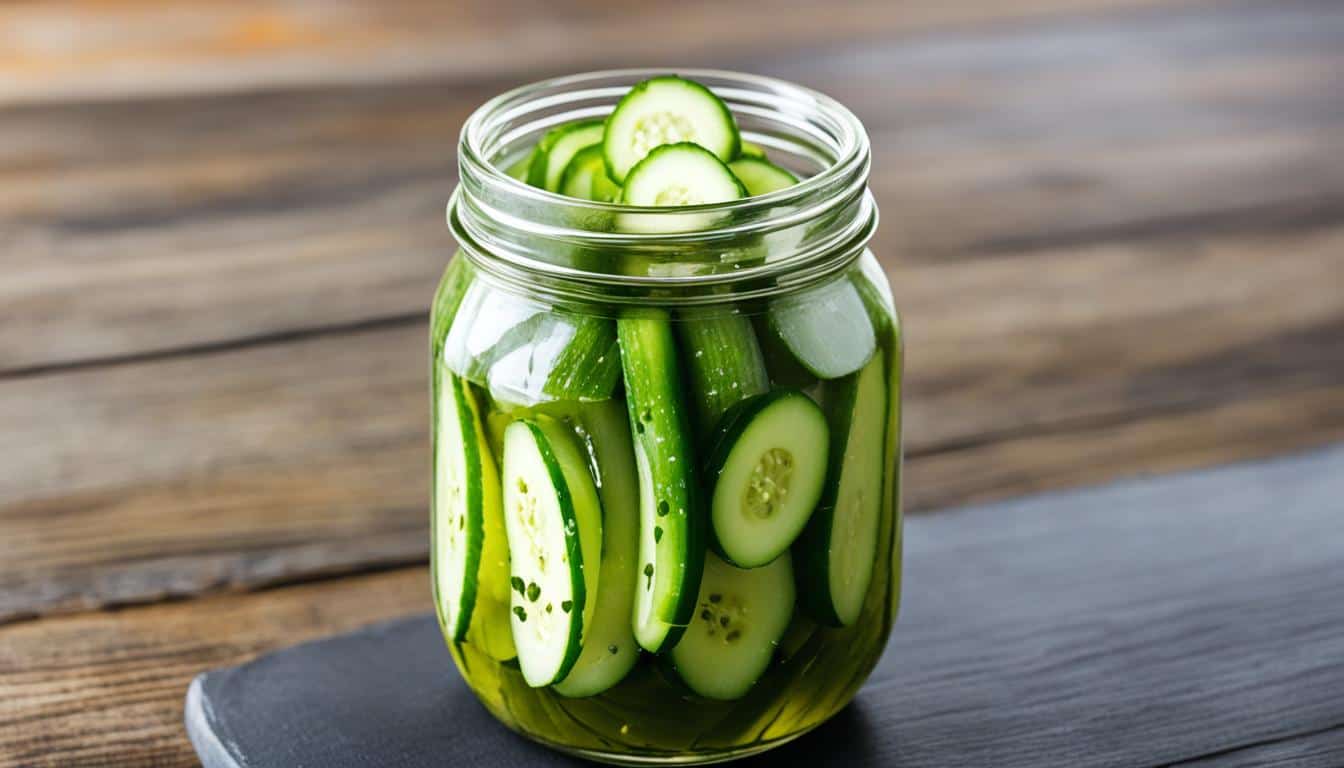
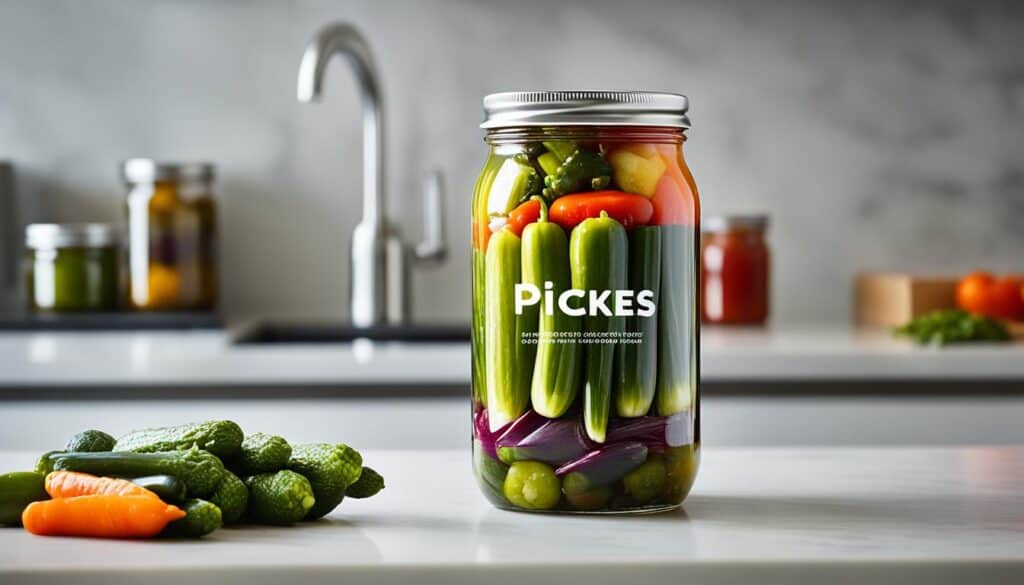
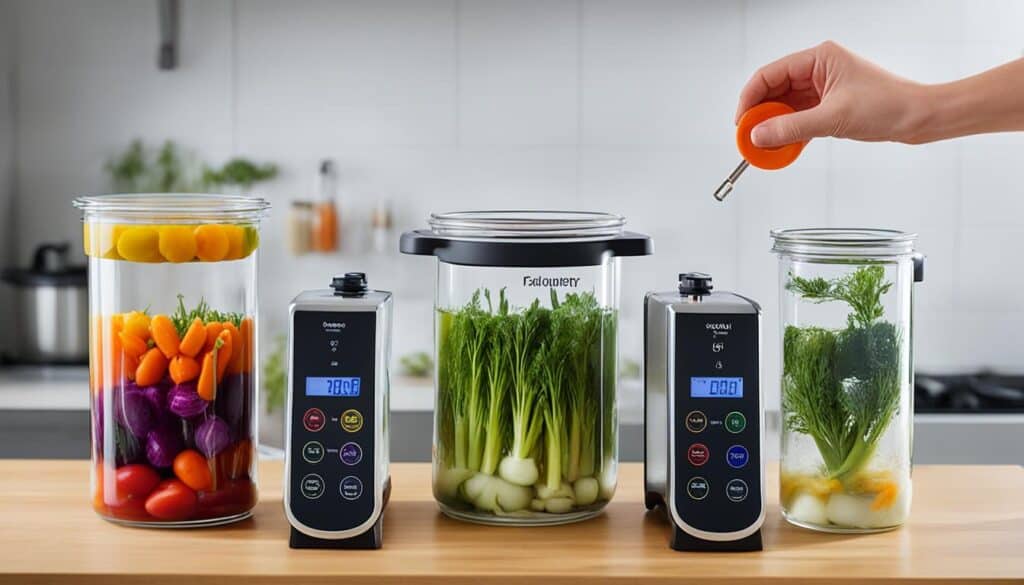
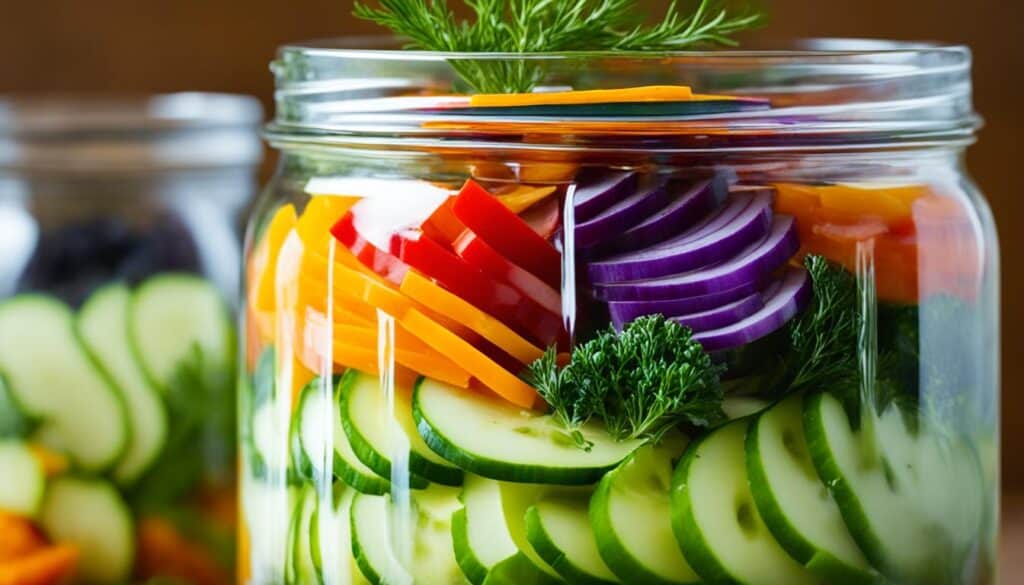
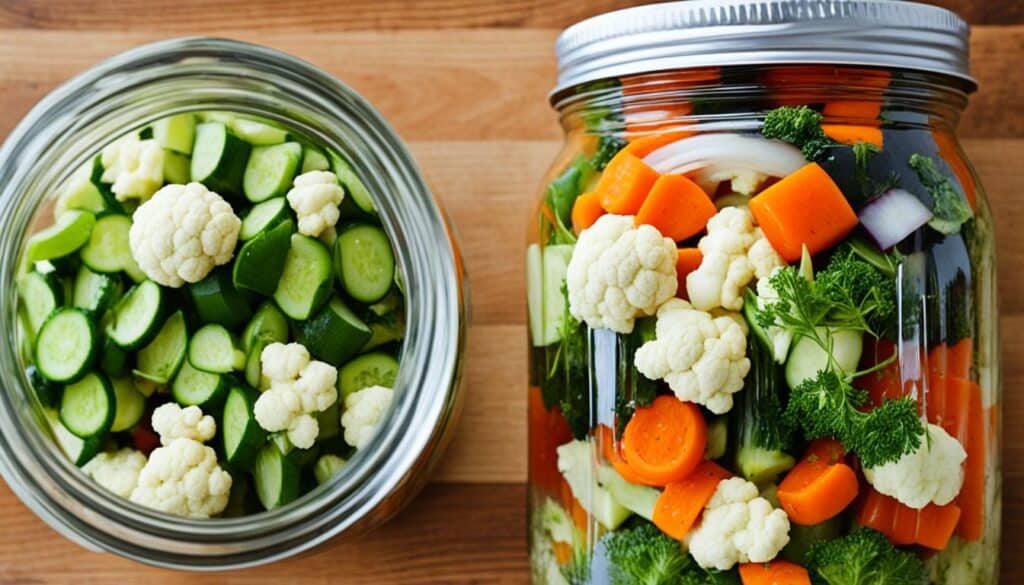
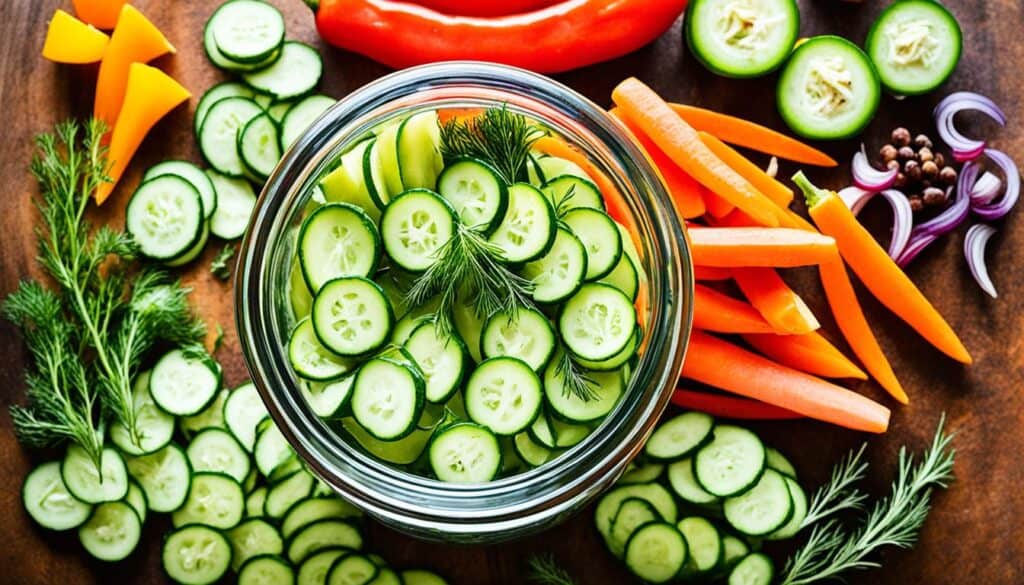



Leave a Reply